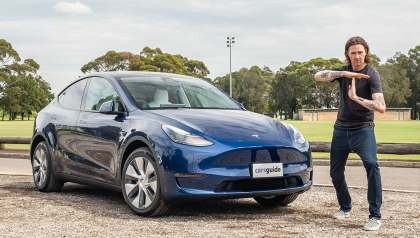The Polestar 2 is only the warm-up act.
Geely’s Volvo-affiliated 'other' Swedish brand, Polestar, is now ready to rise up to the mainstream with the 4 – a premium medium crossover with striking styling, advanced tech and a yearning for a slice of the Tesla Model Y market.
Unrelated to the larger 3 SUV that was unveiled first but has since been delayed, this is expected to be Polestar’s number one seller.
No pressure then. But is it good enough?
-
An EV future is "inevitable" for Australia but that won't stop local car industry fighting against the government's new NVES emissions standard: FCAI
-
Best electric cars arriving in 2024
-
Here's why you're seeing so many Polestar 2 Ubers in New South Wales as the brand defends its premium sporty positioning with new rear-drive update
Polestar 4 2025: Long Range Single Motor
| Engine Type | Not Applicable, 0.0L |
|---|---|
| Fuel Type | Electric |
| Fuel Efficiency | 0.0L/100km (combined) |
| Seating | 5 |
| Price From | $81,500 |
Price and features – Does it represent good value for the price? What features does it come with?
7 / 10
Now, if you’re the new EV disruptor in town you don’t want to the mention the old EV disruptor, so Polestar’s potential Tesla troubler is also targeting the likes of the Audi Q6 e-tron, BMW iX3, Genesis GV60, Lexus NX/RX/RZ, Mercedes-Benz’s GLB/EQB/GLC/EQC and the Porsche Macan. Not all conquest sales are expected to be from other EVs, either.
Two Long Range grades are available at launch – the Single Motor rear-wheel drive (RWD) from $81,500, before on-road costs, as well as the Dual Motor all-wheel drive (AWD) from $93,050.
Cheaper Standard Range models are expected later on.
Speaking of specification, with no back window, standard features include keyless entry/start, a laminated glass roof, pre-conditioning dual-zone climate control with heat pump, a digital rear-view mirror (inevitably, of course), along with a 15.4-inch touchscreen with full Google functionality, surround/bird’s-eye-view cameras, wireless Apple CarPlay/Android Auto, a wireless charger, recycled vegan textile upholstery, powered/heated front seats, seat memory for up to six drivers, ambient lighting, flush door handles, a powered tailgate and 20-inch alloys. But no spare wheel, sadly.
Note that no 4 we sampled had been even remotely close to base, so expected goodies at these price points, such as the dazzling pixel LED headlights, a head-up display and high-end audio, as well as the electrochromic opaque-function sunlight ‘dimming’ for the glass roof, Nappa leather trim, massaging and vented front seats, a powered rear bench and tri-zone rear-seat climate controls.
.jpg)
The larger wheels featured in all the photography you see here, cost extra or are bundled up together – namely the $8000 'Plus Pack', along with the $2500 'Pro Pack' (bigger alloys and fancier trim) and $7200 'Performance Pack' (‘Polestar Engineered’ chassis tune, extra power and 22-inch wheels).
On the safety front, the Polestar’s Volvo connection ensures leading advanced driver-assist systems including adaptive cruise control for next-level crash-avoidance and injury mitigation. More on that in the Safety section below.
And there’s even a Tesla-esque ‘Animal Mode’ climate setting with a twee hi-vis graphic should you dare leave a pet inside your car.
Polestar also makes a big deal about the 4’s traced materials, circularity, sustainability and low-carbon production footprint.
Note that, along with the dramatically stronger performance and AWD security the extra electric motor brings, the Dual Motor also adds active dampers for a softer ride.
The young brand’s most important vehicle ever, the premium-positioned 4 is priced competitively, just above better-specified mainstream alternatives like the Ford Mustang Mach-E, Hyundai Ioniq 5, Kia EV6, Subaru Solterra and Toyota bZ4X, but below the aforementioned more-established rivals.
But the Tesla Y – which is also out of China – substantially undercuts the Polestar on price, if not style.
Design – Is there anything interesting about its design?
9 / 10
Polestar says it didn’t want just another BMW X4 coupe-style SUV clone, because of the inherent packaging compromises such styles of vehicles bring.
Lowering the rear part of a normal, three-box SUV wagon’s roof and giving it a more-fastback shape affects headroom while rendering the now-shallower rear window near-useless.
So, instead, Polestar designed the 4 from scratch to be a low-slung yet spacious crossover SUV, sidestepping the coupe-SUV packaging traps in a number of ways.
This was achieved by pulling the windscreen and front wheels forward, stretching the wheelbase out to three metres (making the latter longer than the brand’s larger 3 SUV’s) and – most importantly – pushing the rear of the roof header panel back rather than down, with only a gentle radius towards the tail to maintain rear-seat ceiling height.
Initially, this resulted in a letterbox back-window slit that served little purpose when reversing, so the controversial decision was made to ditch the glass altogether. Technology to the rescue, though, thanks to a mirror camera helped by surround/bird’s-eye-view displays.
To prove the point, Polestar deposited us amid heavy traffic in the centre of a 6.8-million-strong city. The initial sensation was odd, but we quickly assimilated, aided by the most natural and distortion-free rear-vision camera mirror we’ve ever encountered. The lack of rear window was soon forgotten.
.jpg)
Liberated from the need to provide a back window, the 4’s designers took the opportunity to create a car of stunning freshness and boldness. The bonnet is so low that the front guards and slitted headlights flair up and flank it like some reimagined Porsche 911.
The silhouette extends back gracefully, before falling dramatically over the rear wheel arch with impressively intricate angles, while the plastic panel where the otherwise-useless window would be is its own styling statement when viewed directly rear-on.
With its LED light bar, the effect is stormtrooper helmet, especially in white. The designer mentioned Manga robots as inspiration, but we say Cylon helmet from the reimagined Battlestar Galactica TV series of 2004. One of sci-fi's best shows.
One of the Polestar's design party tricks is its ever-shifting looks depending on vantage point. Seen straight-on front or rear, there's a techno hardness that gradually softens to a feline-esque elegance moving into profile.
The glass roof, frameless door windows, retractable door handles and exquisitely framed exterior mirrors further add lightness and simplicity to an audacious design. The more you drink it in, the more there is to admire.
While not strictly designed from the inside out like, say, BMC’s original Mini, the 4’s interior requirements certainly helped shape the exterior.
So, let’s go inside.
Practicality – How practical is its space and tech inside?
7 / 10
At over 4.8 metres long, two metres wide and a comparatively-squat 1.53m tall, there is no denying the Polestar 4 is more coupe-crossover than SUV wagon.
And these, along with a low floor, stretchy three-metre long wheelbase and a very Swedish approach to minimalism, if not total pragmatism, result in a cabin almost as distinctive as the exterior.
Strangely, while it would seem the interior might be sedan-like low and sleek, in fact it is large and roomy – a corollary to the body’s subtly jacked-up stance, generous girth and lengthy wheelbase. And the opposite of the Polestar 2 liftback.
While not SUV-high, the hip height remains lofty and the sense of space is exacerbated by all the light flooding in from the glass ceiling upon detail-driven Scandinavian-inspired textures and materials, most of which are recyclable and some even vegan.
.jpg)
Yes, for good and for bad, the Tesla cabin ethos’ truly disruptive and far-reaching influences are obvious in this Polestar, though does it make sense to cram all the clutter of buttons virtually into an oversized and overstuffed touchscreen? Is it fair to deny premium buyers the satisfaction of a Volvo 240’s many hefty bombproof mechanisms and controls?
Here’s our biggest interior beef. Although, mercifully, the 4 retains a separate instrumentation cluster and column stalks, losing physical exterior mirror, steering-column adjustment and even glove box buttons/levers is total folly.
You need to use convoluted steering-spoke switchgear and/or the touchscreen and an incantation (probably) for items that previously relied largely on muscle memory to work.
Distracting and stressful, it took several attempts to remember the wheel/mirror adjustment sequences, but as there are memory settings for six driving positions, at least the 4 has a tech workaround for a tech workaround.
We are in the age of contrary ergonomics. How is this progress?
On a more positive note, finding the ideal driving position is easy, on (the optional) lush tombstone front seats that are nothing less than fabulously comfortable and supportive. We can’t tell you how the standard, less-sumptuous chairs feel but the Swedes do have form here.
Taking the time to familiarise it all that Android-system-driven 15.4-inch super-large screen’s design and layout starts to make sense from a multimedia point of view.
Myriad configurations for fast keys, widgets and shortcuts exist, and important/oft-used features like climate, audio and vehicle controls are rarely more than a single prod or sub-menu away. The trick is to learn it all.
Special shout-outs to the 4’s solar system-inspired ambient lighting, optional high-end audio’s bombastic sound quality and the sanctuary-esque climate-controlled environment despite the glass roof above and hot summer sun beaming down.
Not to mention the rich aroma/recycled vegan upholstery juxtaposition that is a million miles away from the tired old luxury car tropes.
Note, though, in two out of three examples, the touchscreen glitched and froze on a few occasions. Polestar assured us these are pre-production hiccups that have since been sorted. We sure hope so.
Entry and exit to and from the back seat is crossover-easy, ahead of limousine-levels of room for legs, as well as ample space for heads and shoulders along the three-person seat.
.jpg)
Backrest angle adjustability is a bonus, cushion comfort is sufficient and amenities are plentiful, including USB ports, vent outlets, cupholders, armrests, lighting and storage all within reach.
While the glass roof opens up the skies above, what’s unusual is the lack of light from behind, as there’s just a removable partition. That further adds to the limo sensation. Where's the party tape!
Further back, the electric tailgate shows a long, flat floor with a low sill for easier loading. The floor is bi-level, and removing the top one reveals a deeper cavity for hidden storage. Note there is no spare wheel, though, just a tyre repair kit.
Cargo capacity is 526 litres (including 31L under the floor), expanding to 1536 litres with the rear seat folded. And Polestar also provides a 15L frunk up front.
Braked towing capacity is 1500kg with the Single Motor and 2000kg in the Dual Motor.
Overall, the 4’s interior is a longer, wider yet lower than most medium-sized SUVs, and sits at the pointy end of its class for quality and ambience.
Under the bonnet – What are the key stats for its motor?
8 / 10
The base rear-drive Polestar 4 uses a permanent magnet synchronous motor located on the back axle to deliver 200kW of power and 343Nm of torque. It can zip to 100km/h in an energetic 7.1 seconds, on the way to a 200km/h top speed.
Meanwhile, the Dual Motor adds another motor up front for AWD, neatly doubling the outputs (to 400kW and 686Nm) while halving acceleration, to just 3.8s.
.jpg)
Efficiency – What is its driving range? What is its charging time?
8 / 10
Being the Long Range version (the only one available at the time of publishing) the 4 is fitted with a 100kWh 400V lithium-ion battery pack with a useable 94kWh.
Polestar reckons the Single Motor offers a WLTP range of 620km, or 590km in the Dual Motor. The latter features a disconnect clutch that disengages the front motor to maximise range. Expect the Standard Range versions coming later on to have smaller battery capacities and so less range.
The WLTP energy consumption numbers are between 17.8 and 21.7 kWh/100km. Our hard-driven Dual Motor test car was showing figures in the mid-20s.
.jpg)
With an 11kW AC charging capacity, you’ll need up to two days to fully charge the 4 from zero at home using a regular plug, but Polestar will sell you a 7.0kW Wallbox to slash that to under 15 hours.
Meanwhile, with up to 200kW of DC charging capability, a 50kW DC public charger only needs about 1.5 hours to go from 10-80 per cent full, or around 45 minutes plugged into an increasingly common 100kW outlet.
To help preserve range, the AWD includes a disconnect clutch, that allows the front motor to disengage when not needed. The 4 also offers bi-directional charging as well as vehicle-to-load (V2L) capability to power appliances. Great for camping!
But, as the low-slung styling and impressive specifications suggest, this SUV Coupe is made for on-road driving pleasure.
.jpg)
Driving – What's it like to drive?
8 / 10
Behind the wheel of the Polestar it turns out to be a tale of two cars – albeit one that may end up with a happier ending than this driving experience in Spain.
Co-developed in China with parent company Geely, the Polestar 4 employs a variation of the flexible 'SEA' architecture found in a number of other models including the coming and closely-related Zeekr 001, and features a four-link suspension design up front and an integral link out back.
The Single Motor RWD base model with a few options seems to be all the 4 you’ll ever need… ample acceleration, very spirited performance and light steering providing enough feedback and feel to be manoeuvrable in tight spots yet involving and rewarding out on country roads. It flows with the driver.
.jpg)
And, though adaptive dampers aren't fitted as per the Dual Motor AWD, the lighter 4 rides more sweetly. The smaller wheel/tyre package seems to help here. There’s a natural fluency to the way it moves with the road that makes it a relaxed, pleasant, easy and comfortable driving experience. It's quite a joy.
Meanwhile, the Dual Motor AWD with Performance Pack as tested has some real advantages over the Single Motor RWD 4 – namely lots of muscle to power you out of situations, with exceptionally fast overtaking responses and a turn of speed that makes it one of the more exhilarating family-orientated EVs for the money. It also looks properly sporty on those oversized alloys.
But… wearing the 22-inch wheel/tyre package, more is less, because with nearly 2.4 tonnes to contend with, the Dual Motor AWD feels that much heavier through tighter corners and bends.
.jpg)
More concerning was the steering, in the test cars we sampled at least.
At lower speeds, the helm felt easy and direct. But with a bit more throttle, there was a lumpiness to it that made the handling seem like it lacked a linear flow of power to the electric power steering system.
In one hairpin, we even heard a grinding noise coming from the front end. Nothing that might affect safety, but given all the performance on offer, we felt you couldn’t quite relax and trust the system to be smooth and composed.
.jpg)
Polestar has since stated to us that all Australian-bound 4s will receive a revised suspension tune relative to the set-up as driven by us in the Dual Motor. It should fix the steering inconsistencies we discovered.
Given we experienced no such issues in the Single Motor version, fitted with the new and updated Euro tune, this is great news for potential buyers.
Everything else lived up to expectations.
.jpg)
Considering the size of the rubber fitted, the Dual Motor Performance Pack rode surprisingly well, and was no doubt aided by the standard adaptive dampers.
And, finally, still on refinement, the 4’s road noise was also low, meaning the series seems to live up to the promise of being a premium coupe SUV alternative to the Tesla Model Y.
Agile, quick, involving and comfy, our appetites have been whetted for this Polestar. We look forward to driving the 4 on Australian roads.
Warranty & Safety Rating
Safety – What safety equipment is fitted? What is its safety rating?
9 / 10
Polestar has not released any crash-test ratings for the 4, though a maximum five-star result is anticipated, given that’s exactly what the related Zeekr 001 has managed recently.
That’s due to an exhaustive list of active and passive safety tech, aided by forward-facing radar, 11 cameras and ultrasonic sensors around/inside the vehicle to anticipate and react to potential hazards.
The 4 leverages the company’s 'Advanced Driver Assist Systems', consisting of AEB vehicle-to-vehicle collision avoidance/mitigation with cyclist and pedestrian detection, advanced collision avoidance, forward collision warning, 'Blind Spot Alert' with steer assist, 'Lane Keeping Aid' (active between 60-200km/h), 'Lane Departure Warning', 'Oncoming Lane Mitigation', 'Driver Alert Control', 'Rear Collision Warning and Mitigation', rear cross-traffic alert (with brake support), traffic sign recognition, post-impact braking, tyre-pressure monitoring, run-off road mitigation and safe exit tech.
.jpg)
ADAS (Advanced Driver Assistance Systems) and AEB operating parameters were not available at the time of publishing.
Also fitted are adaptive cruise control with full stop/go functionality, anti-lock brakes, electronic stability control, 'direct' ultra-fast traction control, seven airbags (two front/two side/front inner-side/two curtains), anti-whiplash head restraints, alarm with interior motion sensors and post-collision automatic door unlocking.
The rear seats include ISOFIX mountings as well as child-seat latch points.
Ownership – What warranty is offered? What are its service intervals? What are its running costs?
7 / 10
Polestar provides a five-year/unlimited kilometre warranty, as well as free servicing for that time frame or the first 100,000km – whichever occurs first.
Outside of these parameters, no capped-price servicing info has been offered at the time of publishing.
An eight-year/160,000km warranty on the lithium-ion battery pack is also offered, meaning it will be replaced for free if it falls under 70 per cent capacity within that period of time. There is also a 12-year anti-corrosion warranty.
Service intervals are every two years or 30,000km.
Verdict
On first acquaintance, the Polestar 4 has the performance, luxury, refinement and dynamics to make a very convincing premium SUV coupe. And one with design flair to boot.
But the Single Motor RWD is more fun to drive as well as more comfortable and relaxed, so that’s probably where our money would go.
Probably? The 4 Dual Motor AWD remains a mystery, as the pre-production Performance Pack representatives we tested were not fitted with the correctly-tuned rear suspension components that adversely affected the AWD version’s steering and handling.
We’ll have to wait until we drive Polestar’s Tesla Model Y rival on Australian roads to see what it's really like, but initial impressions are promising.
Pricing Guides









.jpg)
.jpg)
.jpg)
.jpg)
.jpg)
.jpg)
.jpg)
.jpg)
.jpg)
.jpg)
.jpg)
.jpg)
.jpg)
.jpg)
.jpg)
.jpg)
.jpg)
.jpg)
.jpg)
.jpg)
.jpg)
.jpg)
.jpg)
.jpg)
.jpg)
.jpg)
.jpg)
.jpg)
.jpg)
.jpg)
.jpg)
.jpg)
.jpg)
.jpg)
.jpg)
.jpg)
.jpg)
.jpg)
.jpg)
.jpg)
.jpg)
.jpg)
.jpg)
.jpg)






.png)






.jpg)